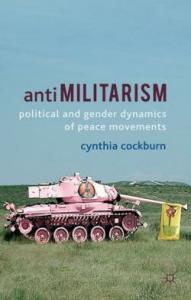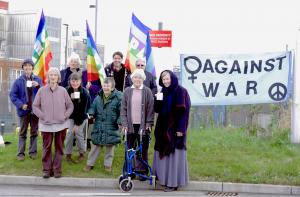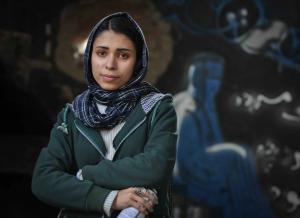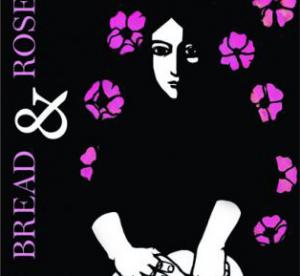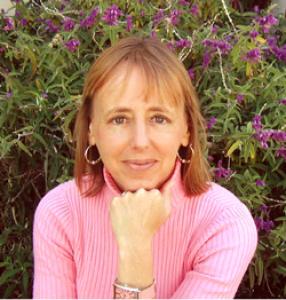Black women’s movement and civil rights activist Olive Morris – who became a symbol of the squatting movement in ’70s Brixton – is one of 30 women profiled and ‘icon-brush[ed] ... with Che Guevara glam’ in the Queen of the Neighbourhood Collective’s book of stencil designs, Revolutionary Women, inspired by the question ‘Who and where are our revolutionary women icons?’ Others featured include Egyptian feminist Doria Shafik, who led the 1951 storming of the Egyptian parliament by 1,500 women…
Women
Protest is alive and well in Berkshire at Aldermaston and Burghfield, the two facilities of the Atomic Weapons Establishment (AWE), where all British nuclear weapons have been designed and made. In 1985, Greenham Women set up Aldermaston Women’s Peace Camp (AWPC) – and we are still there. Whatever the weather, you can find us on the second weekend of every month outside the ‘Citadel’ (A340) gate – look for the peace flags and banners!
“AWE has a poor safety record, with fires,…
I’ve never been that drawn to reading histories of the peace movement but this book, with its particular perspective, has been an exception. I do like a bit of theory and this book has just enough of it, accessibly written, to provide a framework for analysing and understanding the diverse cross-national case studies offered.
The framework is a feminist one which, as Cynthia Cockburn argues, ‘has opened up a pathway for the left’, and is a necessary rather than optional tool for…
Women’s resistance to Trident nuclear weapons continues at Aldermaston Women’s Peace Camp (AWPC). All women are welcome to join us every second weekend of every month (see p16 ‘Regular events’). Fun, good food, great company! Not reliant on the sun! photo: Kay Tabernacle
8,000 women joined the annual “Million Women Rise” International Women’s Day march on 6 March, according to organisers. That’s 3,000 more than last year.
Women travelled from Birmingham, Bournemouth, Bradford, Cornwall, Leeds, Lincoln, Manchester, Nottingham, Oxford, Ireland and Wales, among many other places, to demand an end to male violence against women and children. One placard read: “It’s more dangerous to be a woman than a soldier.” Hundreds of other IWD events took place…
Shamsia, 23, is a graffiti artist in Kabul, Afghanistan. She learned graffiti in December 2010 at a workshop by Combat Communications: ‘I was used to working with paints on canvasses but when I used a spray can for the first time and worked on a big wall it was exciting and cool and such an achievement. I wanted to do something about women’s rights in Afghanistan and the burqa, but in an ironic way and take the idea of the burqa away from how we are used to seeing it.
Image…It’s not really something I ever think about. I’ve never done a women-only action, but I’ve been involved in a few women-only spaces, and that’s been an interesting experience. They’ve generally involved women plus something else though, for example, spaces set up for migrant women.
I do quite a lot of work in very male-dominated groups, so I really feel the difference when I’m in a women-only space. That said, it’s not something I feel particularly strongly about, or that I need or…
Image by Emily Johns
From January to March 1912, women led a successful strike of 25,000 textile workers in Lawrence, Massachusetts, USA. The phrase ‘bread and roses’ was coined to represent the struggle for quality of life as well as wages. See more on the Bread and Roses Centennial website.
Medea Benjamin. PHOTO: Code Pink
PN: What have been the main achievements of the US peace movement since 11 September 2001?
MB: Successes? We moved public opinion from being radically pro-war in the beginning – both in terms of attacking Afghanistan and Iraq – to being overwhelmingly anti-war within the first couple of years and made the war an issue during the presidential elections.
Building an anti-war movement that became…
Women for Life on Earth left Cardiff on 26 August 1981 to march to Berkshire to protest against the siting of Cruise missiles at Greenham Common. The marchers stayed and camped; hundreds of thousands of women came and went, lives were radicalised and liberated. Cruise missiles left 10 years later.
This song by Peggy Seeger, Carry Greenham Home, describes the day of Embrace the Base, an action that was organised in six weeks by chain letter.
Hand in hand, the line extends
…
I was about 24 at the time, and I was there with my small son. The diversity of the women was incredible. For some women Greenham gave them an alternative to our society, it gave a community. Many women came back to Greenham because of the benefits of women living together in co-operation. Despite the hardships that life was preferable. There was concern for each other and support. People got together on an open piece of land, not designed for living on. How they improved their lives,…
According to the South Korean government's estimate, the amount of food needed to feed the North Korean population for the grain financial year of 2003 (November 2002 - October 2003) is 6.32 million tons, up 60 thousand tons from last year. North Korea's total production of grain this year, however, is only 4.13 million tons. Even with the 510 thousand tons provided by the World Food Programme (WFP) and the 250 thousand tons provided by the South Korean government, the hunger stricken…
PN How are Habiba International Women and Youth Affairs struggling for women's rights?
HI By building Somali women's capacity to know and understand their human as well as legal rights, thereby promoting their self-determination and effective involvement in community affairs.
By awakening, stimulating and empowering the Somali women to systematically and effectively assert, claim and defend their legal and human rights and address, monitor and effectively respond to abuses and…
KM: How do themes of peace, justice and environment come to be at the centre of your political life?
JE: I went to Aberystwyth University where I joined Plaid Cymru and became involved in anti-nuclear meetings and the movement against the dumping of waste in Wales.
I went back to the Rhonda in 1980 and we set up Rhonda CND. It was huge - we had more members than the Labour party! It was the same across the country; CND branches set up everywhere. I've been…
Established in 1977, the Revolutionary Association of the Women of Afghanistan (RAWA) is an independent women’s organisation fighting for human rights and social justice in Afghanistan. RAWA opposed the Soviet invasion and occupation of Afghanistan from 1979-89, as well as the subsequent mujahideen and Taliban governments, running underground schools for Afghan girls, publishing a journal and setting up humanitarian projects. Mariam Rawi, a member of RAWA’s foreign relations committee,…



